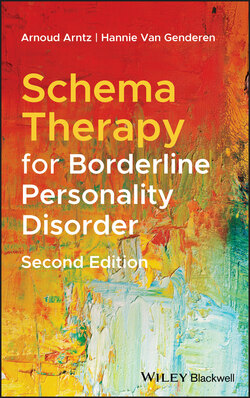Читать книгу Schema Therapy for Borderline Personality Disorder - Hannie van Genderen - Страница 21
Sample dialogue with patient in the angry protector, the bully and attack mode, the self‐aggrandizer, and the punitive parent mode (See ST step by step 5.11, 5.12, 5.13, 5.14, and 5.20)
ОглавлениеT:
When I told you that I have the next week off, your reaction was pretty angry. What mode do you think that reaction came from?
Response from angry protector:
P:
Oh No! We're going to have another lecture about that stupid borderline model of yours? You couldn't wait, could you? Can't think of anything, better can you?
T:
I think your angry protector mode is activated because you feel to be left alone the next week.
P:
Do you really think you're that important for me? I do not need anybody.
Response from a bully and attack mode:
P:
I see that you do not really know what you're talking about. You only pretend to be a good schema therapist.
T:
(he has a tendency to defend himself) I really think I know which side of you is this.
P:
O you are such a loser if you talk like that.
T:
I do not like it when you talk to me like that.
P:
(laughing) Now you are insulted huh? That is not very professional behavior.
Response from a self‐aggrandizer:
P:
I am not angry at all. I am only irritated because you have planned your holiday at the wrong time. Exactly before my holidays. Can't you postpone your holiday?
T:
No, I'm not going to do that. Which side of you thinks I should adapt to you?
P:
Should I explain ST to you? I thought that limited reparenting was the core of your therapy. If you really think that I am important you would postpone your holiday.
Response from punitive parent:
P:
I don't know which “side” of me this is. I only know that I must have been a complete idiot to trust you and that is one mistake I won't make again. It doesn't matter anyway; I'll never get better and I don't deserve to get better.
T:
I think I hear the voice of your punitive parent mode. Maybe that side says that you make a fool of yourself by having sad or angry feelings.
P:
That's not my punitive parent mode, but a fact. It is childish behavior when you only have 1 week holiday.
In the beginning of the therapy, the subtle differences between the angry protector or bully and attack mode and the angry child can also be difficult to distinguish. The differences are primarily evident in the level of anger that is paired with the reaction (see the section “angry/impulsive child”), and in the intention underlying the anger. Whereas, with the angry protector, the intention is to keep others away to protect oneself for being abused, rejected, or abandoned, with the angry child the intention is to protest against maltreatment by others and to get recognition for one's (interpersonal) needs.
These examples involve the protector expressing herself in an active manner. The completely opposite form in which the protector may express herself is by exhibiting tired or sleepy behavior. In this case the therapist must assess whether or not the patient is actually tired or whether she is in the protector mode.
There is the risk that while in the protector mode, the patient may avoid therapy and not work on her problems with a serious chance of her stopping therapy all together. The patient can also have problems with dissociative symptoms, self‐injury, addiction to numbing substances (e.g., drugs or alcohol), or may attempt suicide. Because of this, it is important to identify when the protector mode is present and bypass it. This will give the patient an opportunity to work on her actual problems.
